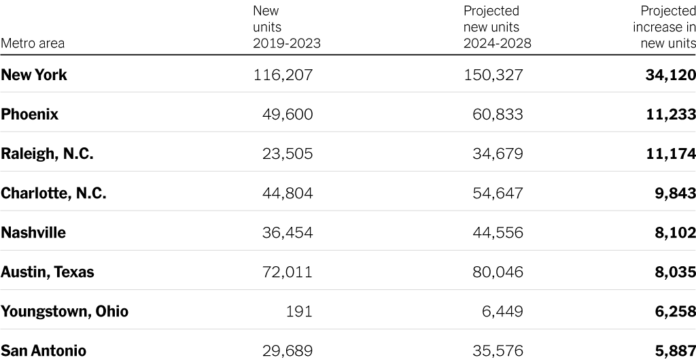In July, the median sales price for homes in the U.S. fell slightly from a record high of $442,389 due to falling interest rates. At the same time, the number of sales reached its lowest level this July, according to Redfin. All indications are that more Americans will continue to rent, at least for now. But where will they live?
Housing is being built at a rapid pace in the United States. According to a study by RentCafe, more than 500,000 units are expected to be completed in 2024, the first year that this threshold is reached. In total, over two million new units are expected by 2028, according to the study. It is unclear how many current units will be lost during this time period.
The New York metropolitan area is expected to lead the way here. In the last five years, from 2019 to 2023, 116,207 new apartments were completed in this area. Only Dallas, with 128,418 apartments, was the second largest construction site here. In the next five years, from 2024 to 2028, 150,327 apartments will be completed in New York. This is the highest number of the major cities examined in the study. Dallas is expected to follow New York and is expected to complete 108,178 apartments by 2028, 20,240 fewer than in the previous five-year period.
The increase in new housing is not limited to large metropolitan areas. In Youngstown, Ohio, for example, only 191 units were completed between 2019 and 2023, but 6,449 are expected to be built over the next five years. The study attributed some of the increase to demand created by an expansion at Youngstown State University. In another small metropolitan area, Sherman, Texas, 617 new housing units were built over the past five years, but 4,001 are expected over the next few years — an increase of 3,384. This week's chart compares the increase in units built over the past five years with what is expected over the next five years.
The study analyzed new housing construction in 369 metropolitan areas, focusing on buildings with 50 or more units. It did not include metropolitan areas with fewer than 300 units or fewer than two such buildings. The Bronx and Staten Island were excluded from New York's totals, missing some of the potential growth: The City Council recently approved a rezoning plan for the Bronx that could create about 7,000 new housing units.
Sign up here for weekly email updates on residential real estate news.















